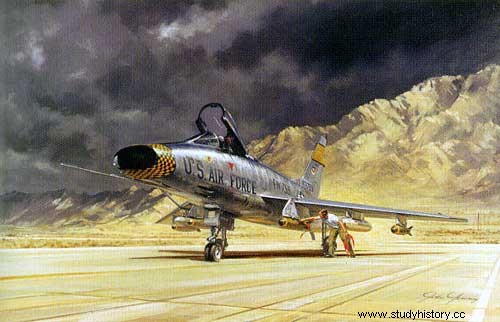
In the early fifties, the long series of "thoroughbreds » launched into the sky by the North American is enriched with a new and exceptional example:the Super Saber. In the Western world, this aircraft ushered in the era of the supersonic fighter, and although derived from its direct predecessor, the F-86 Saber, it presented itself as an entirely different machine. Built in 2,294 units from four basic versions, it entered service in 1954 and remained there for eighteen years, until 1972, ending its intense operational career in Vietnam.
The North American started the project in February 1959 with the intention of perfecting the F-86 Saber and making it a supersonic machine. But the operational phase of the program did not begin until two years later when the USAF - in search of new combat aircraft capable of intervening effectively in the Korean conflict - authorized the construction of two prototypes, called YF-100A. Made and equipped in great secrecy, the first of these flew on May 25, 1953. From its maiden flight, it demonstrated its great capabilities and easily exceeded the speed of sound.
The Super Saber was a relatively sophisticated aircraft for its time, capable of exploiting. fully the great power of the J57 turbojet which propelled it. Thus, on October 29, 1953, at the hands of the chief test pilot of the USAF base at Edwards, F.K. Everest, the YF-100A prototype conquered, flying at a few tens of meters of altitude, the absolute average speed record of 1,214.28 kilometers per hour. That same day, the first of 203 examples of the first production version, the F-100A, also flew.
A series of serious accidents unfortunately delayed the operational use of these machines and caused, in November 1954, the cessation of flights, pending a technical investigation. The North American engineers carried out this quickly and, in a little over three months, managed to determine the causes of the problems that had arisen and to introduce the solutions directly on the assembly lines (in addition to small modifications of detail, they enlarged the surface of the vertical planes and slightly increased that of the wings). While the production of the first version continued, the USAF authorized, in February 1957, the construction of a fighter-bomber, called F-100C, characterized above all by reinforced wings, by a more powerful engine, by a capacity in fuel and by the possibility of being refueled in flight. The first F-100C flew on January 17, 1955 and delivery to detachments of the first 476 units made began six months later. Despite an increase in weight, these planes proved to be even faster than the previous ones. On August 20, 1955, an F-100C broke another world speed record, averaging 1,322.81 kilometers per hour.
A month earlier, the Americans had started production of the third basic version, the F-100D. This presented important changes in the structure, in the equipment and on-board electronics, as well as in the armament which, in addition to the tactical nuclear bombs already provided for on the previous aircraft, also included air-to-land missiles. and air to air. The first F-1000 flew on January 24, 1956 and production totaled 1,274 examples, distributed between North American's Los Angeles and Columbus (Ohio) factories. The last model of the Super Saber was used for operational training and, as such, was a two-seater. The first F-100F flew on August 3, 1956 and the production of 339 copies continued until October 1959.
The Super Saber also equipped the air forces of some allied countries:the Nationalist China (80 F-100A adapted to the D version), Turkey (260 F-100C), Denmark and France.
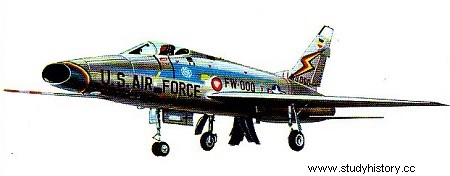
Commitments
The Hun accomplished most of his missions during the Vietnam War. After being again modernized in electronics, radio and navigation, it was then used as a bomber, fighter, reconnaissance aircraft and ground attack aircraft. In total, the United States Air Force lost 243 F-100s in Vietnam, including 198 in combat.
Turkish F-100s participated in Operation Attila (invasion of Cyprus in 1974). A Turkish F-100F was shot down on September 17, 1983 by a Matra R530 missile fired by an Iraqi Dassault Mirage F1 following a border violation.
dates
commissioning date :1953
end of use date :1970
Number built 2,294
Nationalities
Constructor :USA
 Users:
Users:
- USA
- France
- Canada
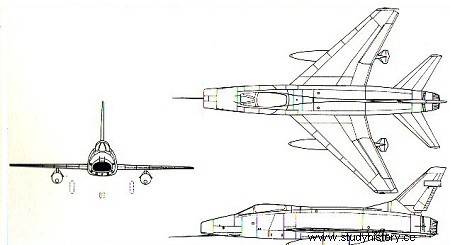
Categories
 Fighter Bomber
Fighter Bomber
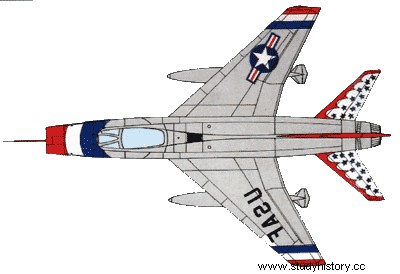
Technical and Performance Data
 Wingspan:11.81 m;
Wingspan:11.81 m;
 Length:15.10 m,
Length:15.10 m,
 Height:4.26 m.
Height:4.26 m.
 Weight:9,285 kg,
Weight:9,285 kg,
 Maximum weight:15,800 kg
Maximum weight:15,800 kg
 Maximum Load:
Maximum Load:
 Surface:
Surface:
 Maximum altitude:13,720 m
Maximum altitude:13,720 m
 Range:(two 1,420 I tanks) 2,415 km.
Range:(two 1,420 I tanks) 2,415 km.
 Maximum speed:1,390 km/h, Mach 1.31 at altitude
Maximum speed:1,390 km/h, Mach 1.31 at altitude
 Ascent Speed:4,900 m/min
Ascent Speed:4,900 m/min
 Practice Cap:
Practice Cap:
 Cruising speed:
Cruising speed:
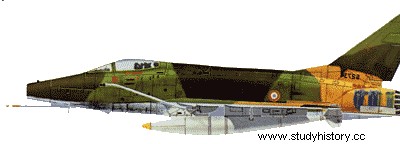
Motorisation (engines or reactors)
 a Pratt &Whitney J57 turbojet afterburner, (most A) J57-7 6,576 kg;
a Pratt &Whitney J57 turbojet afterburner, (most A) J57-7 6,576 kg;
Armaments
 4 × M-39E 20mm 200-round guns
4 × M-39E 20mm 200-round guns
 pylons for 2 supersonic tanks of 1420 I and 4 additional anchor points (rarely used) for load of 1816kg; (C, D) 2 tanks and 6 pylons for a load of 3,402 kg; (F) 2 tanks and maximum load of 2,722 kg.
pylons for 2 supersonic tanks of 1420 I and 4 additional anchor points (rarely used) for load of 1816kg; (C, D) 2 tanks and 6 pylons for a load of 3,402 kg; (F) 2 tanks and maximum load of 2,722 kg.
